Impact of Southbound Expansion on Clustered OpenFlow Software-Defined Network Controller Synchronisation Using ODL and ONOS
Abstract
:1. Introduction
1.1. Research Challenges
- What effect does the selection of controller clustering techniques have on the control communication volume among controllers across various network topologies?To address this research question, we investigate the effect of controller clustering techniques, particularly ODL cluster and ONOS, on the volume of control communications in three network topologies (torus, linear, and tree). The variation in control communication volume between these two types of controllers for a given network topology is also investigated.
- What are the key factors that influence the decrease in control communication volume in an ODL cluster leaderless compared to an ONOS leader-based controller cluster?We address this research question by examining the factors that contribute to lower control communication volume per second in the ODL cluster compared to the ONOS controller cluster. This investigation helps identify the reasons behind the observed differences and determine what contributes to them.
- What challenges did the ODL method face with an increase in the number of southbound devices compared to the ONOS method?This question focuses on the challenges specific to ODL cluster communication when scaling up the number of southbound devices. It aims to understand the reasons behind the exponential increase in the cluster communication volume observed in ODL compared to the more gradual increase in ONOS.
1.2. Research Contribution
- We provide a comprehensive analysis of the communication patterns observed in ODL and ONOS clusters. In doing so, we offer insights into the behaviors of different cluster coordination operations in torus, linear, and tree network topologies.
- We evaluate the system performance, focusing on the scalability of ODL and ONOS controllers. In doing so, we provide guidelines for selecting the appropriate controller based on the size of the southbound network.
- We conduct a detailed comparison of the coordination patterns among controller clusters, including the time intervals between each cluster. The differences observed in large-scale network environments and the challenges faced by each controller cluster provide a better understanding of the strengths and limitations of ODL and ONOS SDN clusters.
1.3. Structure of the Article
2. Related Work
3. Distribution and Coordination Factors of Clustered Controllers
3.1. Distributed Architectures
3.1.1. Logically Centralised Architecture
3.1.2. Logically Distributed Architecture
3.2. Coordination Strategies
3.2.1. Leader-Based Strategy
3.2.2. Leaderless Strategy
4. Impact of Southbound Expansion for Cluster Performance Influences
5. Southbound Implementation in Leader-Based/Leaderless Controller Clusters
5.1. Evaluation Environment Settings
5.2. Experimental Topology
6. Results and Discussion
6.1. Cluster Initialisation
6.2. Impact of Southbound Expansion in Tree Topology
6.3. Impact of Southbound Expansion on Linear Topology
6.4. Impact of Southbound Expansion on Torus Topology
7. Conclusions and Future Directions
Author Contributions
Funding
Institutional Review Board Statement
Informed Consent Statement
Data Availability Statement
Conflicts of Interest
References
- Anerousis, N.; Chemouil, P.; Lazar, A.A.; Mihai, N.; Weinstein, S.B. The Origin and Evolution of Open Programmable Networks and SDN. IEEE Commun. Surv. Tutor. 2021, 23, 1956–1971. [Google Scholar] [CrossRef]
- McKeown, N.; Anderson, T.; Balakrishnan, H.; Parulkar, G.; Peterson, L.; Rexford, J.; Shenker, S.; Turner, J. OpenFlow: Enabling Innovation in Campus Networks. SIGCOMM Comput. Commun. Rev. 2008, 38, 69–74. [Google Scholar] [CrossRef]
- Kreutz, D.; Ramos, F.M.V.; Veríssimo, P.E.; Rothenberg, C.E.; Azodolmolky, S.; Uhlig, S. Software-Defined Networking: A Comprehensive Survey. Proc. IEEE 2015, 103, 14–76. [Google Scholar] [CrossRef]
- Abu Abd-Allah, A.G.; Aya Sedky Adly, A.Z.G. Scalability between Flow Tables & Multiple Controllers in Software Defined Networking. J. Comput. Sci. IJCSIS 2019, 17, 23–44. [Google Scholar]
- Phemius, K.; Bouet, M.; Leguay, J. DISCO: Distributed multi-domain SDN controllers. In Proceedings of the 2014 IEEE Network Operations and Management Symposium (NOMS), Krakow, Poland, 5–9 May 2014; pp. 1–4. [Google Scholar] [CrossRef]
- Cox, J.H.; Chung, J.; Donovan, S.; Ivey, J.; Clark, R.J.; Riley, G.; Owen, H.L. Advancing Software-Defined Networks: A Survey. IEEE Access 2017, 5, 25487–25526. [Google Scholar] [CrossRef]
- Erel, M.; Teoman, E.; Özçevik, Y.; Seçinti, G.; Canberk, B. Scalability analysis and flow admission control in mininet-based SDN environment. In Proceedings of the 2015 IEEE Conference on Network Function Virtualization and Software Defined Network (NFV-SDN), San Francisco, CA, USA, 18–21 November 2015; pp. 18–19. [Google Scholar] [CrossRef]
- Kim, T.; Choi, S.G.; Myung, J.; Lim, C.G. Load balancing on distributed datastore in opendaylight SDN controller cluster. In Proceedings of the 2017 IEEE Conference on Network Softwarization (NetSoft), Bologna, Italy, 3–7 July 2017; pp. 1–3. [Google Scholar] [CrossRef]
- Chaipet, S.; Putthividhya, W. On Studying of Scalability in Single-Controller Software-Defined Networks. In Proceedings of the 2019 11th International Conference on Knowledge and Smart Technology (KST), Phuket, Thailand, 23–26 January 2019; pp. 158–163. [Google Scholar] [CrossRef]
- Muqaddas, A.S.; Giaccone, P.; Bianco, A.; Maier, G. Inter-Controller Traffic to Support Consistency in ONOS Clusters. IEEE Trans. Netw. Serv. Manag. 2017, 14, 1018–1031. [Google Scholar] [CrossRef]
- Suh, D.; Jang, S.; Han, S.; Pack, S.; Kim, M.S.; Kim, T.; Lim, C.G. Toward Highly Available and Scalable Software Defined Networks for Service Providers. IEEE Commun. Mag. 2017, 55, 100–107. [Google Scholar] [CrossRef]
- Lunagariya, D.; Goswami, B. A Comparative Performance Analysis of Stellar SDN Controllers using Emulators. In Proceedings of the 2021 International Conference on Advances in Electrical, Computing, Communication and Sustainable Technologies (ICAECT), Bhilai, India, 19–20 February 2021; pp. 1–9. [Google Scholar] [CrossRef]
- Sri Deepak Phaneendra, Y.; Prabu, U.; Yasmine, S. A Study on Multi-Controller Placement Problem (MCPP) in Software-Defined Networks. In Proceedings of the 2023 International Conference on Sustainable Computing and Data Communication Systems (ICSCDS), Erode, India, 23–25 March 2023; pp. 1454–1458. [Google Scholar] [CrossRef]
- Shirvar, A.; Goswami, B. Performance Comparison of Software-Defined Network Controllers. In Proceedings of the 2021 International Conference on Advances in Electrical, Computing, Communication and Sustainable Technologies (ICAECT), Bhilai, India, 19–20 February 2021; pp. 1–13. [Google Scholar] [CrossRef]
- Niu, X.; Guan, J.; Gao, X.; Jiang, S. Scalable and Reliable SDN Multi-Controller System Based on Trusted Multi-Chain. In Proceedings of the 2022 IEEE 33rd Annual International Symposium on Personal, Indoor and Mobile Radio Communications (PIMRC), Virtually. 12–15 September 2022; pp. 758–763. [Google Scholar] [CrossRef]
- Xu, H.; Li, Q. SDN Multi Controller Deployment Strategy Based on Improved Spectral Clustering Algorithm. In Proceedings of the 2022 7th International Conference on Intelligent Computing and Signal Processing (ICSP), Virtually. 15–17 April 2022; pp. 117–120. [Google Scholar] [CrossRef]
- Hu, F.; Hao, Q.; Bao, K. A Survey on Software-Defined Network and OpenFlow: From Concept to Implementation. IEEE Commun. Surv. Tutor. 2014, 16, 2181–2206. [Google Scholar] [CrossRef]
- de Oliveira, R.L.S.; Schweitzer, C.M.; Shinoda, A.A.; Prete, L.R. Using Mininet for emulation and prototyping Software-Defined Networks. In Proceedings of the 2014 IEEE Colombian Conference on Communications and Computing (COLCOM), Bogota, Colombia, 4–6 June 2014; pp. 1–6. [Google Scholar] [CrossRef]
- Goyal, P.; Goyal, A. Comparative study of two most popular packet sniffing tools-Tcpdump and Wireshark. In Proceedings of the 2017 9th International Conference on Computational Intelligence and Communication Networks (CICN), Cyprus, Turkey, 16–17 September 2017; pp. 77–81. [Google Scholar] [CrossRef]
- Espinel Sarmiento, D.; Lebre, A.; Nussbaum, L.; Chari, A. Decentralized SDN Control Plane for a Distributed Cloud-Edge Infrastructure: A Survey. IEEE Commun. Surv. Tutor. 2021, 23, 256–281. [Google Scholar] [CrossRef]
- Bannour, F.; Souihi, S.; Mellouk, A. Distributed SDN Control: Survey, Taxonomy, and Challenges. IEEE Commun. Surv. Tutor. 2018, 20, 333–354. [Google Scholar] [CrossRef]
- Yan, B.; Xu, Y.; Chao, H.J. BigMaC: Reactive Network-Wide Policy Caching for SDN Policy Enforcement. IEEE J. Sel. Areas Commun. 2018, 36, 2675–2687. [Google Scholar] [CrossRef]
- Görkemli, B.; Tatlıcıoğlu, S.; Tekalp, A.M.; Civanlar, S.; Lokman, E. Dynamic Control Plane for SDN at Scale. IEEE J. Sel. Areas Commun. 2018, 36, 2688–2701. [Google Scholar] [CrossRef]
- Amiri, E.; Alizadeh, E.; Raeisi, K. An Efficient Hierarchical Distributed SDN Controller Model. In Proceedings of the 2019 5th Conference on Knowledge Based Engineering and Innovation (KBEI), Tehran, Iran, 28 February–1 March 2019; pp. 553–557. [Google Scholar] [CrossRef]
- Hu, T.; Guo, Z.; Yi, P.; Baker, T.; Lan, J. Multi-controller Based Software-Defined Networking: A Survey. IEEE Access 2018, 6, 15980–15996. [Google Scholar] [CrossRef]
- Nguyen-Ngoc, A.; Lange, S.; Zinner, T.; Seufert, M.; Tran-Gia, P.; Aerts, N.; Hock, D. Performance evaluation of selective flow monitoring in the ONOS controller. In Proceedings of the 2017 13th International Conference on Network and Service Management (CNSM), Tokyo, Japan, 26–30 November 2017; pp. 1–6. [Google Scholar] [CrossRef]
- Open Networking Foundation. Open Network Operating System (ONOS®) Is the Leading Open Source SDN Controller for Building Next-Generation SDN/NFV Solutions. October 2021. Available online: https://www.opendaylight.org/ (accessed on 18 July 2024).
- OpenDaylight. OpenDaylight (ODL) Is a Modular Open Platform for Customizing and Automating Networks of Any Size and Scale. October 2021. Available online: https://www.opendaylight.org/ (accessed on 18 July 2024).
- Lord, P.; Roy, A.; Keys, C.; Ratnaparkhi, A.; Goebel, D.M.; Hart, W.; Lai, P.; Solish, B.; Snyder, S. Beyond TRL 9: Achieving the Dream of Better, Faster, Cheaper Through Matured TRL 10 Commercial Technologies. In Proceedings of the 2019 IEEE Aerospace Conference, Big Sky, MT, USA, 2–9 March 2019; pp. 1–17. [Google Scholar] [CrossRef]
- Septian, K.A.; Istikmal; Ginting, I. Analysis of ONOS Clustering Performance on Software Defined Network. In Proceedings of the 2021 IEEE International Conference on Internet of Things and Intelligence Systems (IoTaIS), Bandung, Indonesia, 23–24 November 2021; pp. 117–122. [Google Scholar] [CrossRef]
- Suh, D.; Jang, S.; Han, S.; Pack, S.; Kim, T.; Kwak, J. On performance of OpenDaylight clustering. In Proceedings of the 2016 IEEE NetSoft Conference and Workshops (NetSoft), Virtually. 23–24 November 2016; pp. 407–410. [Google Scholar] [CrossRef]
- Arahunashi, A.K.; Neethu, S.; Ravish Aradhya, H.V. Performance Analysis of Various SDN Controllers in Mininet Emulator. In Proceedings of the 2019 4th International Conference on Recent Trends on Electronics, Information, Communication Technology (RTEICT), Khulna, Bangladesh, 20–22 December 2019; pp. 752–756. [Google Scholar] [CrossRef]
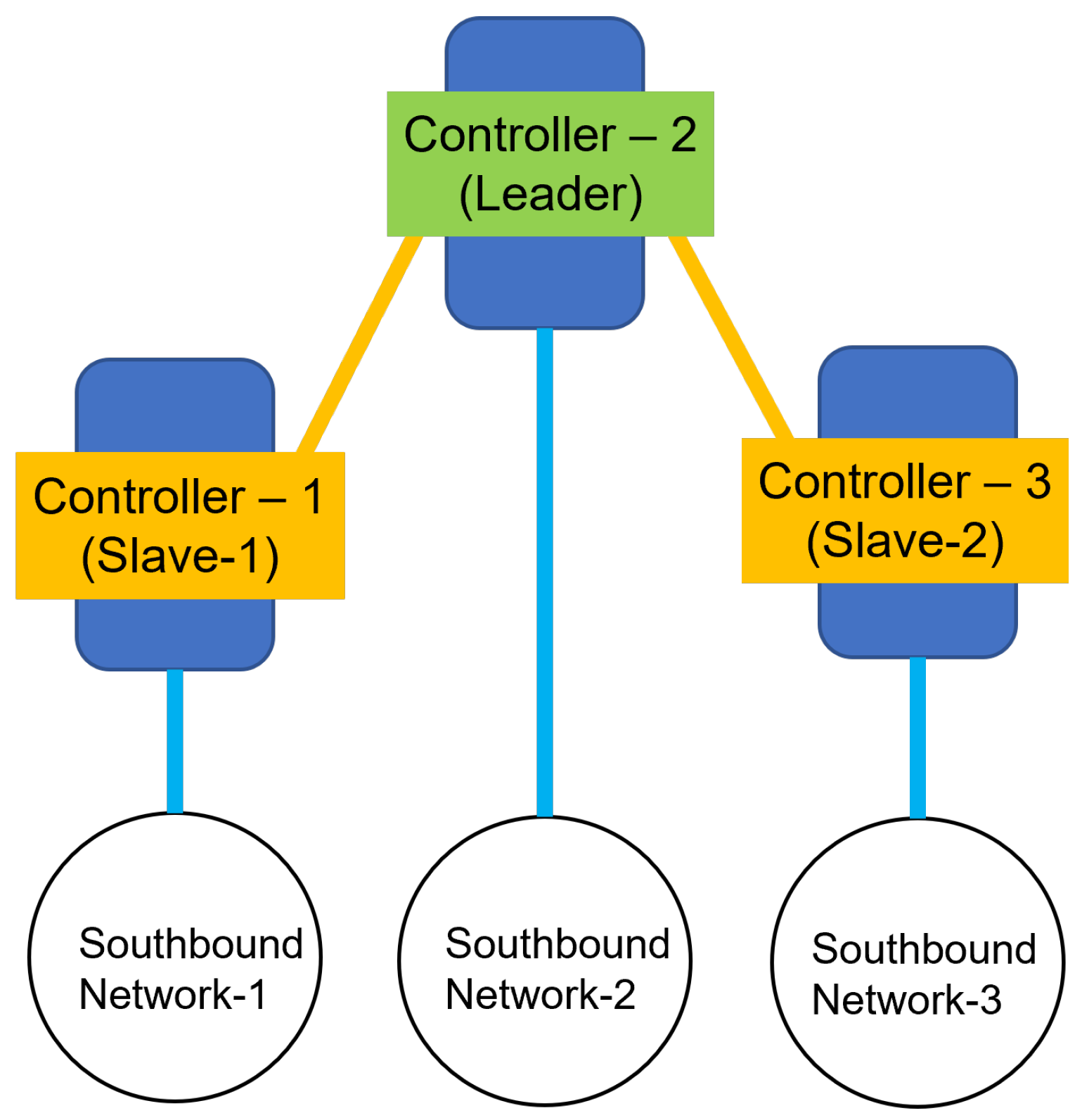


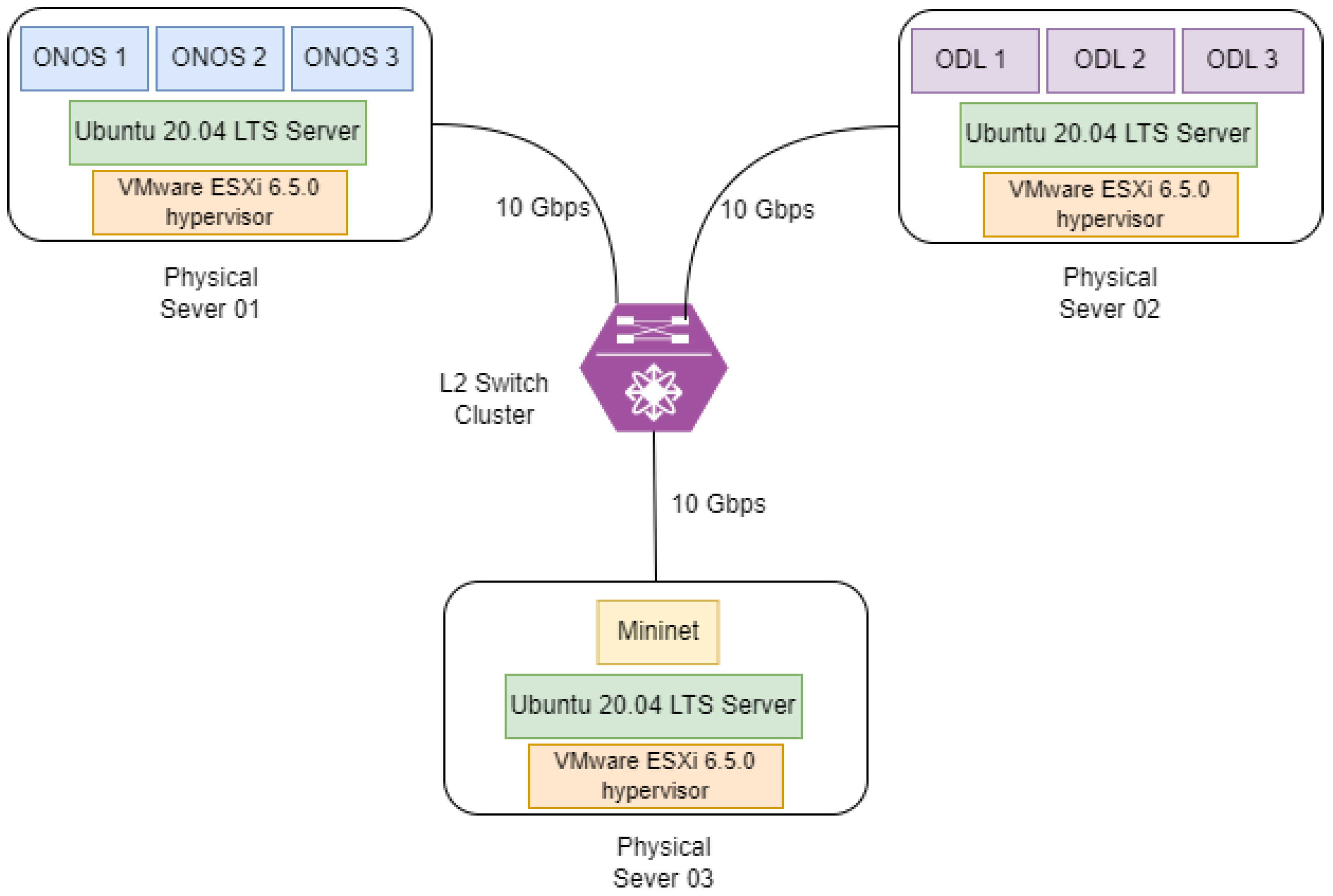


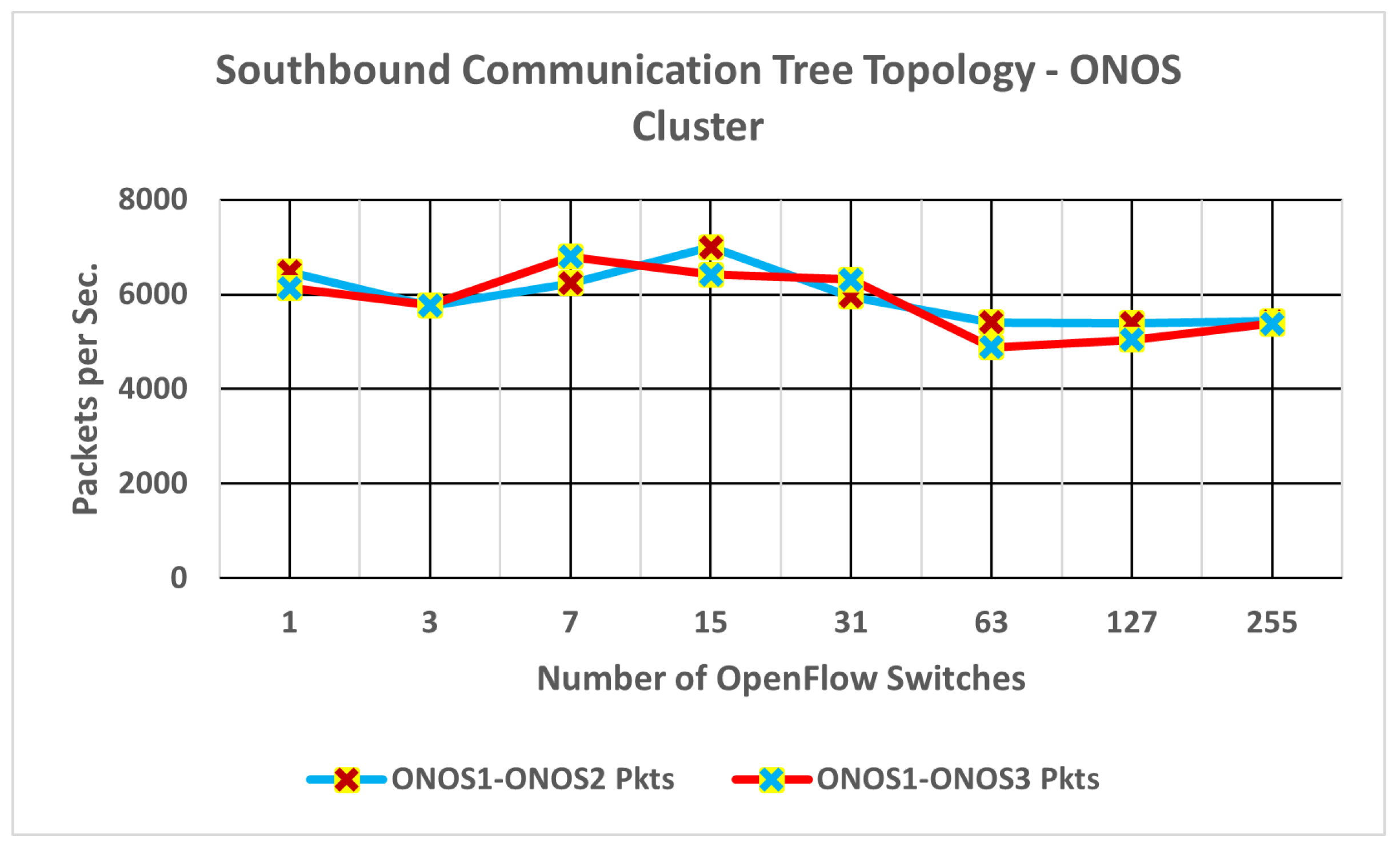
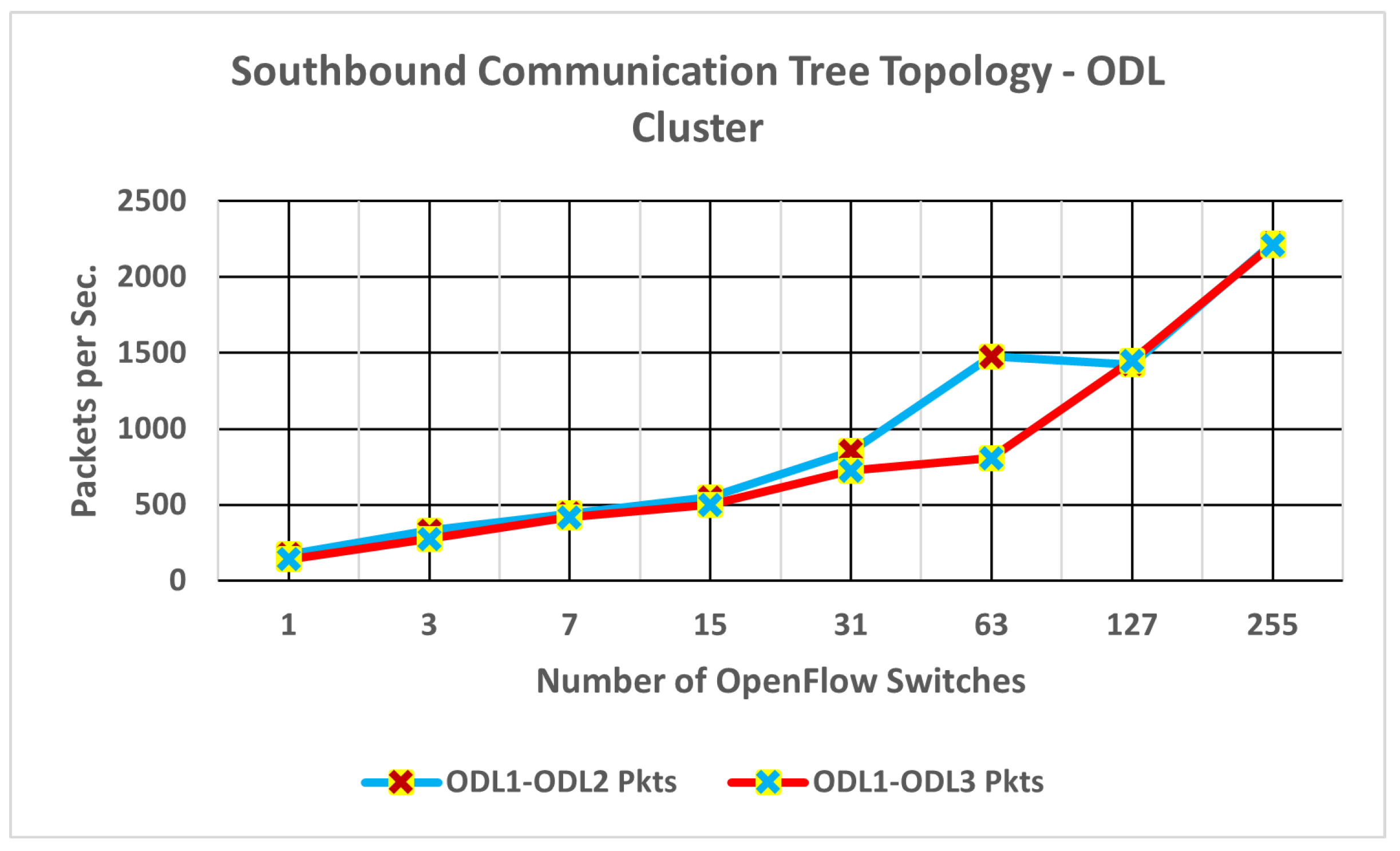
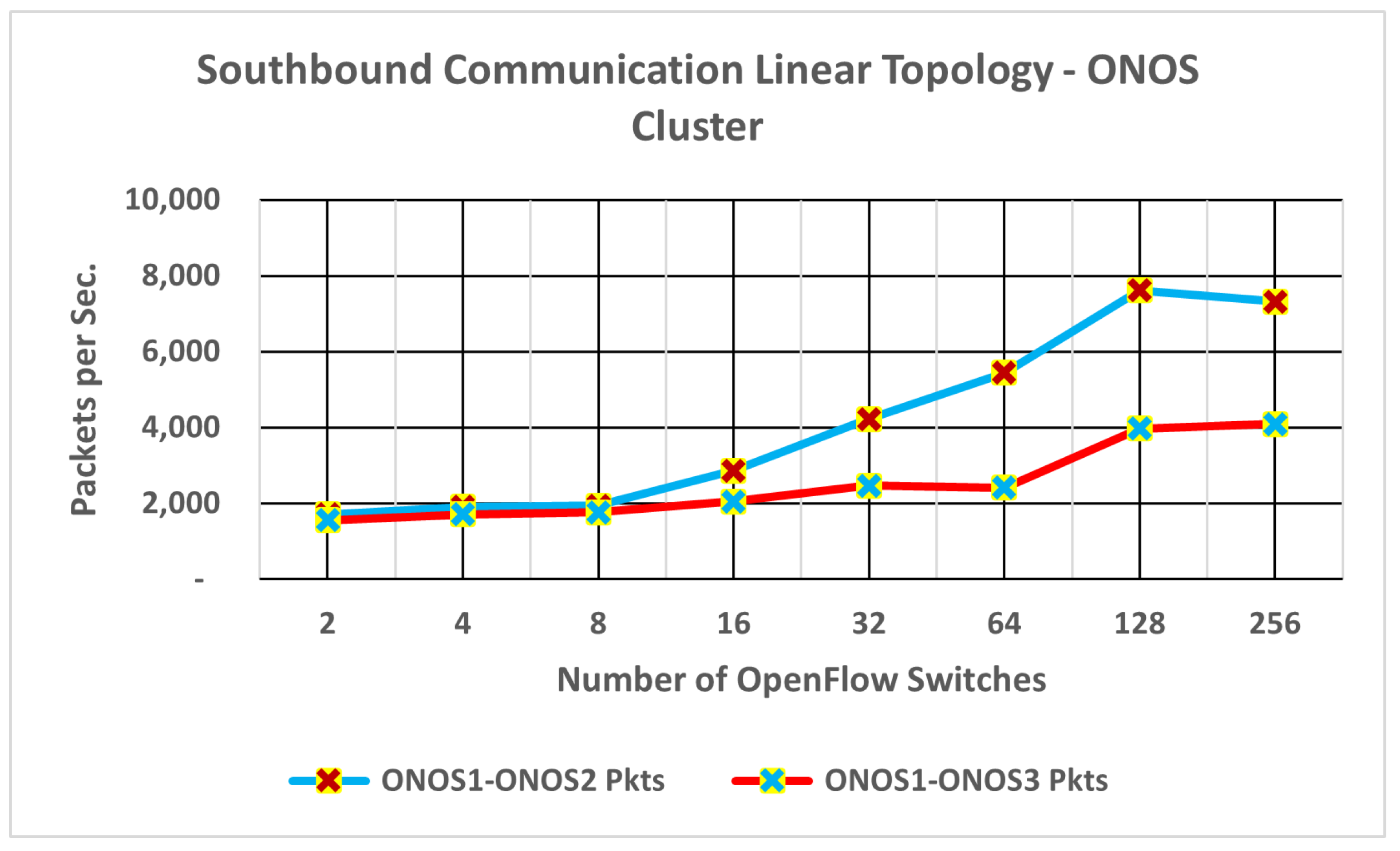

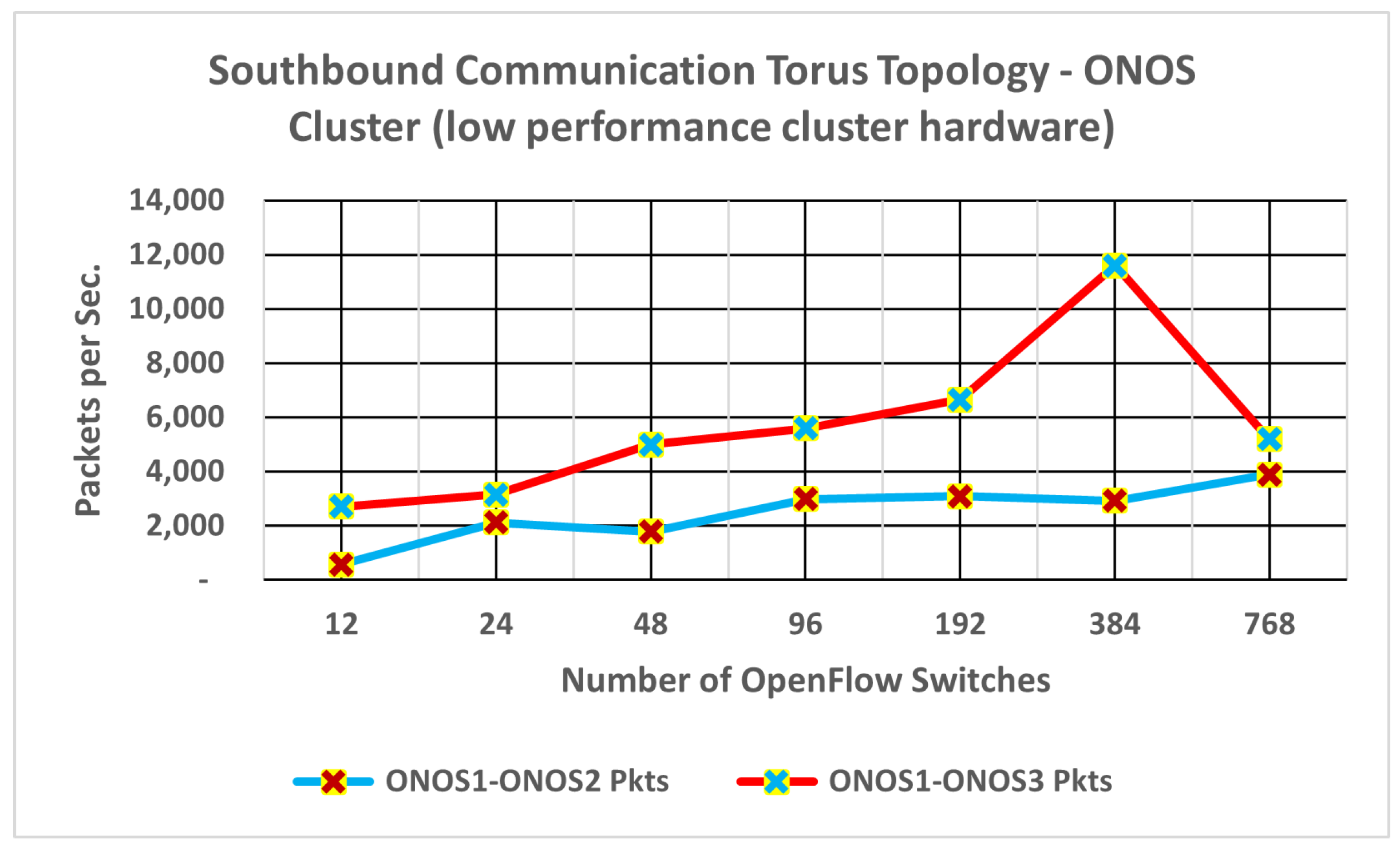
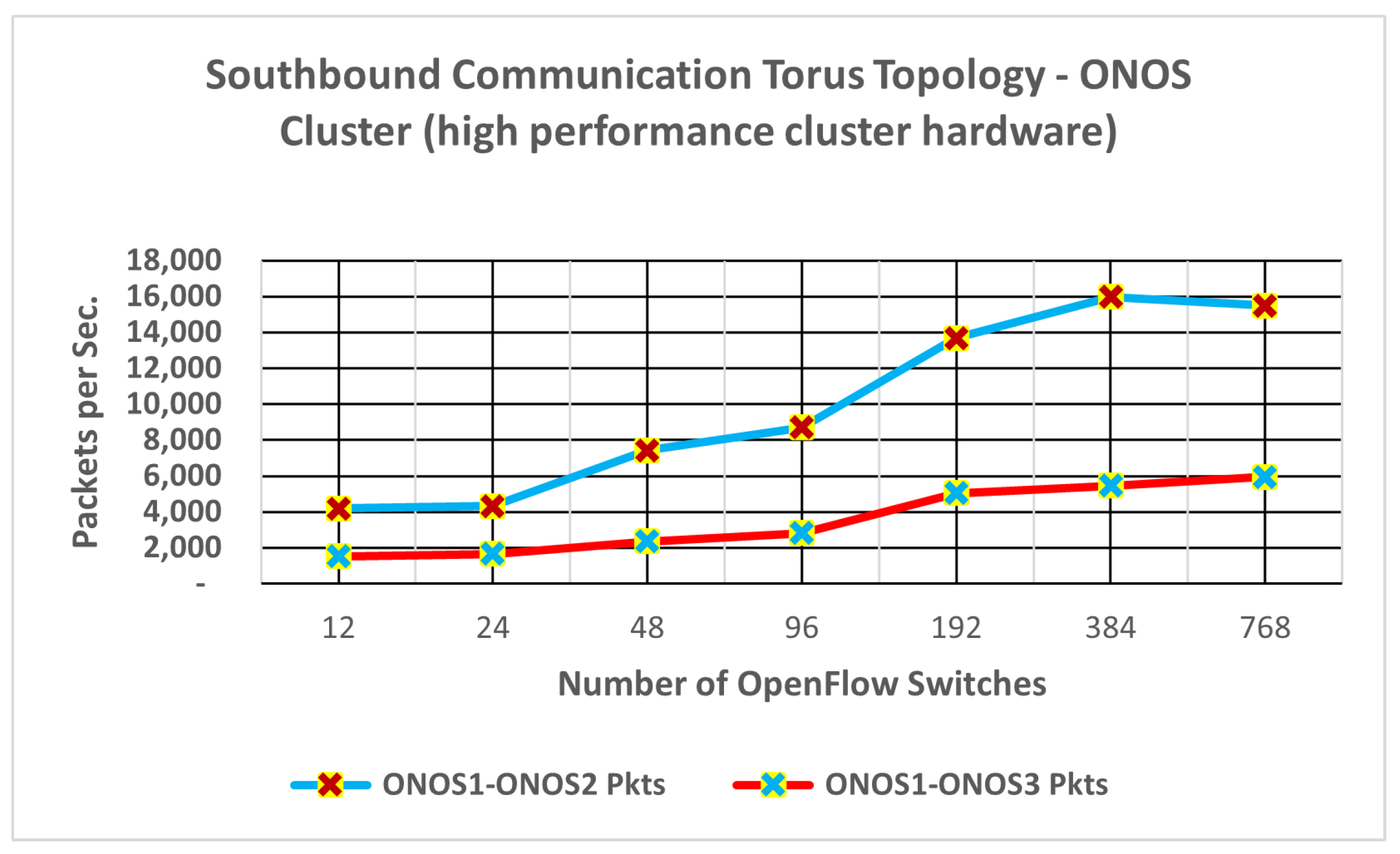

| Criteria | Single Controller | Multi-Controllers | ||
|---|---|---|---|---|
| POX | Ryu | ODL | ONOS | |
| First Release in | 2011 | 2012 | 2013 | 2014 |
| Architecture | Centralised | Centralised | Distributed | Distributed |
| East–West | NA | NA | Available | Available |
| Language | Python | Python | Java | Java |
| Modularity | Poor | Medium | Very Good | Very Good |
| Consistency | No | Yes | Yes | Yes |
| Updates | Poor | Medium | Very Good | Very Good |
| Industry Proven | No | No | Yes | Yes |
| Scenario | OpenFlow Switch Count | Host Count | Link Count |
|---|---|---|---|
| 01 | 01 | 02 | 02 |
| 02 | 03 | 04 | 06 |
| 03 | 07 | 08 | 14 |
| 04 | 15 | 16 | 30 |
| 05 | 31 | 32 | 62 |
| 06 | 63 | 64 | 126 |
| 07 | 127 | 128 | 254 |
| 08 | 255 | 256 | 510 |
| Scenario | OpenFlow Switch Count | Host Count | Link Count |
|---|---|---|---|
| 01 | 02 | 02 | 03 |
| 02 | 04 | 04 | 07 |
| 03 | 08 | 08 | 15 |
| 04 | 16 | 16 | 31 |
| 05 | 32 | 32 | 63 |
| 06 | 64 | 64 | 127 |
| 07 | 128 | 128 | 255 |
| 08 | 256 | 256 | 511 |
| Scenario | OpenFlow Switch Count | Host Count | Link Count |
|---|---|---|---|
| 01 | 12 | 12 | 36 |
| 02 | 24 | 24 | 72 |
| 03 | 48 | 48 | 144 |
| 04 | 96 | 96 | 288 |
| 05 | 192 | 192 | 576 |
| 06 | 384 | 384 | 1152 |
| 07 | 768 | 768 | 2304 |
Disclaimer/Publisher’s Note: The statements, opinions and data contained in all publications are solely those of the individual author(s) and contributor(s) and not of MDPI and/or the editor(s). MDPI and/or the editor(s) disclaim responsibility for any injury to people or property resulting from any ideas, methods, instructions or products referred to in the content. |
© 2024 by the authors. Licensee MDPI, Basel, Switzerland. This article is an open access article distributed under the terms and conditions of the Creative Commons Attribution (CC BY) license (https://creativecommons.org/licenses/by/4.0/).
Share and Cite
Hettiarachchi, E.D.S.I.; Sarkar, N.I.; Gutierrez, J. Impact of Southbound Expansion on Clustered OpenFlow Software-Defined Network Controller Synchronisation Using ODL and ONOS. Information 2024, 15, 440. https://doi.org/10.3390/info15080440
Hettiarachchi EDSI, Sarkar NI, Gutierrez J. Impact of Southbound Expansion on Clustered OpenFlow Software-Defined Network Controller Synchronisation Using ODL and ONOS. Information. 2024; 15(8):440. https://doi.org/10.3390/info15080440
Chicago/Turabian StyleHettiarachchi, Egodahettiarachchige Don Sarada Indumini, Nurul I. Sarkar, and Jairo Gutierrez. 2024. "Impact of Southbound Expansion on Clustered OpenFlow Software-Defined Network Controller Synchronisation Using ODL and ONOS" Information 15, no. 8: 440. https://doi.org/10.3390/info15080440
APA StyleHettiarachchi, E. D. S. I., Sarkar, N. I., & Gutierrez, J. (2024). Impact of Southbound Expansion on Clustered OpenFlow Software-Defined Network Controller Synchronisation Using ODL and ONOS. Information, 15(8), 440. https://doi.org/10.3390/info15080440








